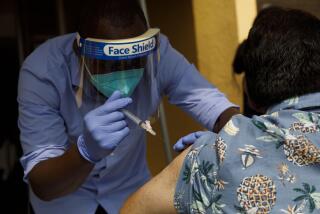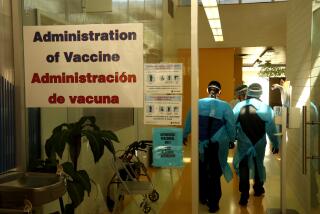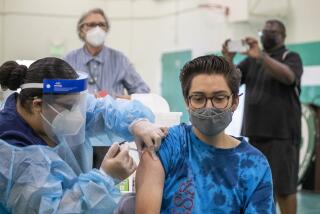L.A. County’s challenge: delivering swine flu vaccine effectively
- Share via
The Times’ Oct. 19 editorial, “Fighting swine flu,” criticizes the vaccination efforts of the Los Angeles County Department of Public Health (which I head) for not focusing enough on schools. While it is true that L.A. County’s inoculation program isn’t as focused on schools as New York City’s is, The Times’ criticism of our efforts reflects a misunderstanding by the editorial board of our outreach to schools, our extensive H1N1 vaccination efforts and the unique features of our county.
There are many different models for preventing and controlling flu outbreaks in communities. While it seems intuitive for schools to serve as H1N1 vaccination sites, logistical challenges -- including working with more than 80 school districts in the county, record-keeping and the need to obtain and track parental consent -- make schools less than ideal sites for mass vaccination. Staffing presents a particular challenge, as not all schools have nurses, and the public health department lacks the resources required to staff a broad, school-based vaccination effort.
This doesn’t mean the county is completely ignoring schools. In fact, we will visit schools that can manage the logistics with parental consent. We are also working closely with school districts (including the Los Angeles Unified School District and the county’s Office of Education), private schools, colleges and universities on personal hygiene and flu prevention messages, return-to-school policies and illness outbreak investigations.
The Times points to New York as an example of a city aggressively fighting swine flu by targeting schools. New York’s efforts are commendable, but bear in mind it has only one school district. Other large cities, such as Boston and San Diego, are not pursuing a school-based vaccine effort either but are, like L.A. County, relying on private providers’ ability to administer the vaccine.
During normal flu seasons, the Department of Public Health vaccinates only about 6% of county residents who undergo inoculation. With the H1N1 virus, the department will vastly increase its normal share to, we hope, 20% of the swine flu vaccines administered in L.A. County. Private healthcare providers, some pharmacies and other sources will cover the rest.
Our primary means of administering the vaccine will be through large-scale, free vaccination clinics that will be set up throughout the county for residents who do not have health insurance or a regular source of healthcare. While these clinics may not be at schools, school-aged children are a key priority group, and we fully anticipate that many of them will be vaccinated at our community sites.
Vaccination is the most important means of preventing a flu outbreak. The work required to obtain enough doses of the H1N1 vaccine and coordinate the numerous vaccine clinics for L.A. County residents has been immense. Our H1N1 program, the largest inoculation effort in the county’s history, is focused on providing this important vaccine in the most effective way possible. We feel our program does exactly that.
Jonathan E. Fielding is director of the Los Angeles County Department of Public Health.
More to Read
Sign up for Essential California
The most important California stories and recommendations in your inbox every morning.
You may occasionally receive promotional content from the Los Angeles Times.










